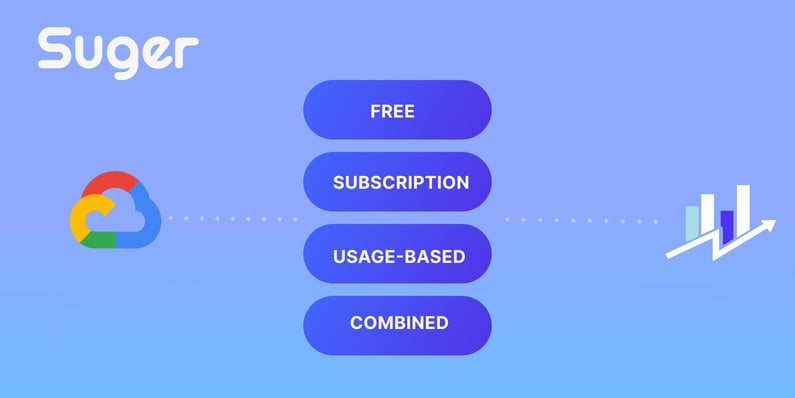Cloud marketplaces have become a powerful channel for scaling SaaS businesses. In 2023, SaaS giants like CrowdStrike, Snowflake, and Palo Alto Networks each reported over $1 billion in revenue through the Cloud Marketplace alone. For early-stage companies, especially AI startups, creating the right pricing strategy is critical to maximizing market potential and meeting customer needs.
In this article, we'll explore three key strategies for building an effective SaaS pricing model for GCP.

1. Understand GCP Marketplace Pricing Models
GCP Marketplace offers several pricing models, and selecting the right one is crucial for attracting a diverse customer base. Here are some common pricing models:
- Free: Customers only pay for the Google Cloud resources they use. Top-performing companies often use a free model to open up the top of the funnel, allowing users to sign up at no cost. As new users become active, there’s a strong foundation for future customer growth.
- Subscription Pricing: Customers pay a flat monthly fee for using your software. Subscription models offer flexibility by allowing buyers to choose payment plans that align with their budgets. Providing both annual and monthly subscription options can secure predictable revenue streams.
-
Pay-as-You-Go (PAYG)/Usage-based: This model allows customers to pay based on actual usage of your SaaS product. PAYG is ideal for cloud architects and developers who need flexible, on-demand access to solutions. This flexibility encourages users to test your product without committing to upfront costs, scaling as needed. For example, Salesforce mulls consumption pricing for AI agents.
“When we look at pricing, it will be on a consumption basis,” CEO of Salesforce, Marc Benioff said. “Salesforce may go with a per-conversation charge or sell consumption credits as it does with Data Cloud.”
-
Combined Pricing: In this model, customers pay a base subscription fee with additional usage charges. For example, a base plan might include a certain number of API requests, with additional fees as usage increases.

2. Prioritize Transparency and Align Pricing with Delivered Value
Your SaaS pricing strategy should always align with the value your product delivers to customers. Transparency in pricing is key, as customers appreciate clarity and consistency. The goal is to balance your pricing with the benefits your customers gain, such as cost savings, increased productivity, or scalability.
For SaaS companies, especially those offering AI tools, adding a usage-based component to the pricing model can drive significant value. A case in point: HubSpot initially struggled with low net revenue retention (~70%) due to an overly rigid subscription model. After introducing usage-based pricing in 2011, which aligned pricing with customer success, net revenue retention jumped to nearly 100%.

- Customer Segmentation: Tailor your pricing to different customer segments based on company size, industry, or specific needs. For example, a small AI startup may prefer an affordable entry-level plan, while an enterprise customer may be willing to invest in premium features and higher-tier options.
- Value Metrics: Consider tying pricing to value metrics such as API calls, storage, or compute power. This allows for a scalable model that grows with customer usage.
3. Buyers first, Offer Flexible Billing and Payment Terms
Flexibility in billing and payment terms can be a powerful incentive for attracting a wider customer base. Many companies prefer payment options that align with their cash flow and financial planning. Offering this flexibility helps you accommodate different buyer types and close deals faster.
- Annual vs. Monthly Billing: Offering annual payments at a discount encourages long-term commitments and provides stable revenue. Monthly billing, on the other hand, is more appealing to smaller businesses or those with limited budgets, as it reduces upfront costs.
- Custom Terms for High-Value Clients: For larger customers, consider offering custom terms or private offers. While public offers on the GCP Marketplace are excellent for low- to mid-tier purchases, private offers allow you to negotiate bespoke pricing and payment schedules for enterprise clients. Check more, how to create private offers.
Start Simple with Suger's Metered Billing Capabilities
One way to create a buyer-first approach is by implementing metered billing. By directly linking costs to usage, you can tangibly prove value to your customers. Moreover, sharing detailed usage data in invoices builds trust in your brand even after the deal is closed.
Setting up metered billing can be complex, requiring cross-functional collaboration across finance, revops, sales, and engineering teams. That’s where Suger comes in!
Suger offers flexible pricing model configurations, more intuitive filters, and a smoother billing operation experience. You can track usage in real-time, ensuring accurate billable metrics and setting trigger alerts for potential overages — giving your team peace of mind while keeping customers satisfied. Contact us today to learn more!